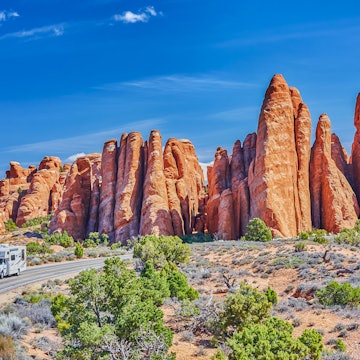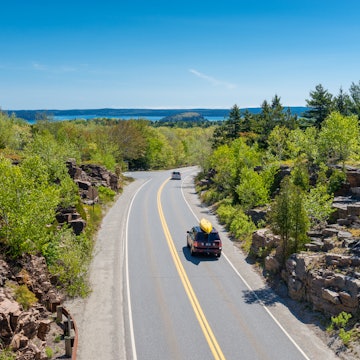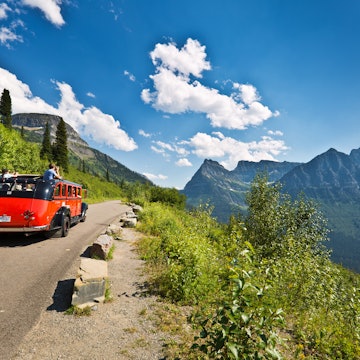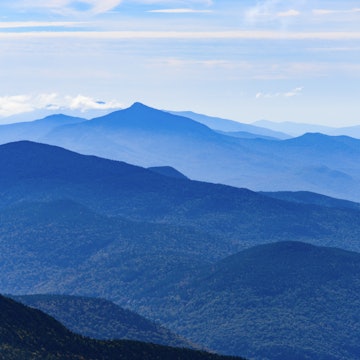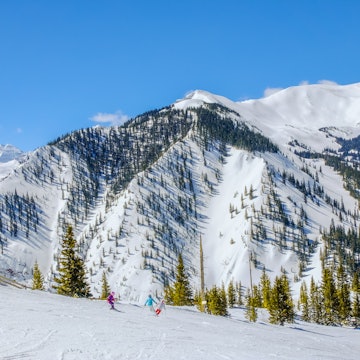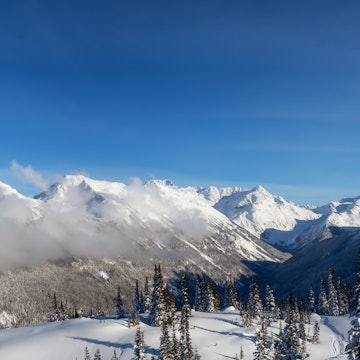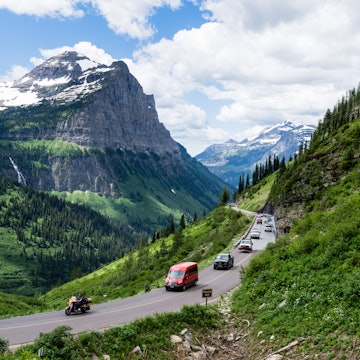

Experience the very best of Canada's outdoor adventures with this guide © Ryan Brown / Getty Images
From soaring mountain peaks to sparkling emerald lakes; frozen glaciers to lush forests, Canada is teeming with outdoor pursuits.
Low population density in the world’s second-largest country means you can have many of the natural wonders all to yourself. Whether you’re looking to encounter wildlife, train like an Olympic athlete or simply get outside, these quintessential Canadian adventures are sure to get your heart racing.
1. Marvel at “Iceberg Alley”
Every spring and summer, giant icebergs make their way from Greenland to the northern and eastern coasts of Newfoundland and Labrador.
There are so many — ranging in color from glistening white to deep aquamarine — the area has been aptly coined “Iceberg Alley,” attracting locals and visitors alike to take an iceberg safari (look for icebergs and post pictures of what you found online). A few of the more popular spots to see the icebergs are St. Lewis, Cape Spear, Change Islands, Bonavista and La Scie.
The 15,000-year-old glacial giants, that have followed this trek for thousands of years, are not only a feast for the eyes, locals use them to source water for spirits like “Iceberg Vodka” and “Iceberg Beer”. A visit in the summer provides opportunities to witness the migration of the world’s largest population of humpback whales.

2. Surf the cool shores of Tofino
Canada’s Pacific Coast is not for the faint of heart — the water reaches its peak warmth in July at about 13ºC (55ºF). Still, surfers flock here year-round to ride the reliable waves that make up Tofino’s 35km (22 miles) of surfable beach. From the gentle waters of Cox Bay and Chesterman Beach to the more challenging swells at Long Beach – the longest beach on the island – there’s a wave for every skill level.
Back on land, more adventure awaits on the many hiking trails that make up Pacific Rim National Park Reserve, home to some of the oldest trees in Canada. Visiting outside the summer season? Spring and autumn are the time to stop by for whale-watching off the shores of Long Beach, while a visit between November and February offers spectacular storm watching for photographers.
3. Canoe the placid waters of Algonquin Park
Arguably no summer activity is more Ontarian than canoeing or kayaking on one of the province’s many lakes. You’ll find some of the most peaceful and picturesque in Algonquin Provincial Park, just over a two-hour drive north of Toronto.
Over 7560km (4700 miles) of rolling hills and verdant forests make the park ripe for exploration, while more than 1930km (1200 miles) of canoe routes call canoers to get out on the water. Whether you’re seeking a multi-day trip or a leisurely one-hour ride, you’re sure to see plenty of wildlife (think, beavers and loons, and if you’re lucky, a moose).

4. Dogsled across frozen lakes in the Yukon
While the Yukon’s main draw is hunting for the northern lights at night, an equally thrilling experience is found during the day, mushing with a team of dogs. Up to 16 rambunctious dogs lead you on a several-hour tour across frozen lakes and through thick boreal forests.
They get a quick refuel break while you enjoy a warm lunch over the fire, complete with steaming hot chocolate. After lunch, it’s back on the snowy trails, where you can take your pick of sitting inside the dogsled or, for a more thrilling ride, standing at the back (make sure you hold on tight!).
5. Hike the cliffs of Gros Morne National Park
From the rugged coastline to the verdant forest inland Gros Morne National Park is filled with natural wonders to explore. Its distinguishing feature is the unique red rock of the Tablelands, exposed mantle that formed from the tectonic plates colliding nearly 500 million years ago.
The other standout attraction is the Western Brook Pond, home to soaring cliffs that ascend over 600m (2000ft) into the sky. The easiest way to experience it is by hiking the under two-mile trail that begins near the parking lot off the highway and heads inland towards the pond.
More adventurous hikers can opt instead for the Long Range Traverse, a 21-mile backcountry route that starts at the pond and takes three to four nights to complete.

6. Ski and snowboard in Whistler
From Quebec’s Mont Tremblant to Banff’s Sunshine Village, Canada has no shortage of mountains to ski and snowboard. But arguably none is as iconic as Whistler.
As the former venue of the 2010 Olympic and Paralympic games, the two mountains that straddle Whistler and Blackcomb offer world-class skiing and snowboarding.
But even before the Olympics, this ski town has long attracted alpine enthusiasts from around the world to its pristine pistes. Adventurers are kept busy in the summer too, with the region’s varied elevations lending themselves to a variety of terrains, each with their own activities from canoeing to hiking to paddleboarding.
7. Bobsleigh like an Olympian in Calgary
It’s been 34 years since the 1988 Winter Olympic and Paralympic Games, and Calgary’s Olympic Park remains a destination for alpine enthusiasts. With ziplining, mountain biking and skiing, the recreational facilities offer all kinds of activities for thrill seekers year-round.
Those with a need for speed will want to try the bobsleigh track, which has you racing around 10 turns at upwards of 80kph (50mph). The activity is available in the summer, as is downhilll karting, which offers a similar adrenaline rush with 50 twists and turns in a luge cart on a downhill track.

8. Walk along the edge of the tallest building in Canada
For many, standing on the glass floor of the CN Tower’s observation deck is enough of a thrill. But adrenaline junkies will want to head outside to the EdgeWalk – the world’s highest hands-free walk on a wide ledge that circles the CN Tower’s main pod.
Leaning over the Toronto skyline 548m (1800ft) into the sky, it’s no wonder this attraction is a Guinness World Record breaker and the first of its kind in North America.
9. Soar over frozen glaciers
Whether you’re visiting in the summer or winter, a flightseeing tour over the Southern Lakes of the Yukon is a once-in-a-lifetime experience. In the summer, the Southern Lakes are crystal clear while in the winter, they present a vast arctic tundra, perfect for spotting a crossing caribou herd.
Whatever the season, you’ll pass interesting attractions like an old mine and mining town, and Teresa Island, the tallest mountain island of any freshwater in North America. The real highlight, however, is flying over Llewellyn Glacier in the winter — the frozen icefields are a jaw-dropping sight you will never forget.

10. Kayak with killer whales
Johnstone Strait is home to two types of orcas — mammal-eating transient killer whales and fish-eating resident killer whales — making it one of the best places in the world to observe the gentle giants. A kayak tour with one of several operators in the region gets you front-row seats to watch the whales feed on salmon off the north coast of Vancouver Island.
But that’s not all, the calm coastal inlets and water channels are teeming with wildlife, like dolphins, sea lions and bald eagles while the island itself offers hiking trails through old growth cedars, with plenty of opportunities to learn about Indigenous culture.
11. Ice climb the frozen waterfalls of Johnston Canyon
Every winter, the upper falls of Johnston Canyon in Banff National Park freeze into massive columns of ice, making them a snowy playground for ice climbers. Rising 30m (98ft) above ground, you can join the many thrill seekers climbing the frozen pillars.
You’ll find climbers here in the summer too, scaling the Canyon’s giant rocks. Prefer to keep your feet on the ground? Several tour operators lead ice walks through the Canyon, beginning with a gentle stroll through the lower falls and ending with the awe-inspiring upper falls.
The falls are also spectacular in the summer too, attracting hikers to the Canyon’s well-developed trails.









